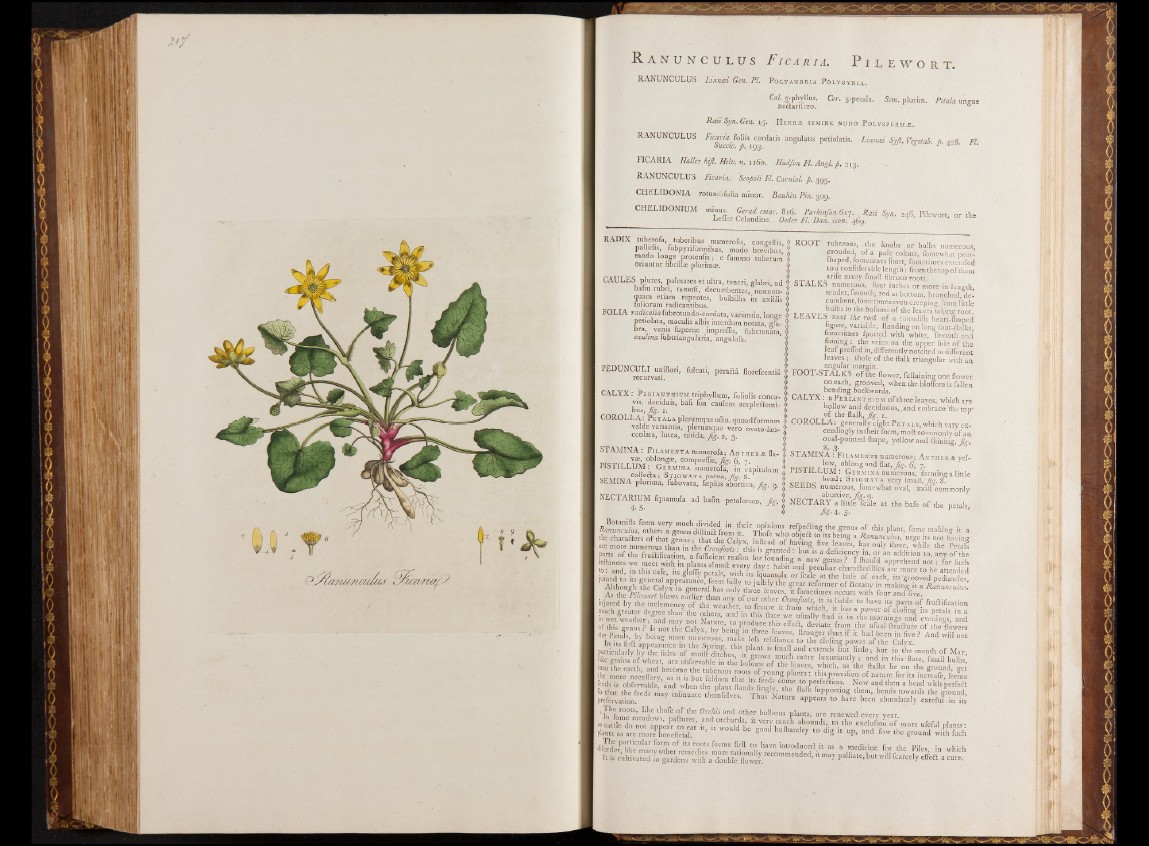
R a n u n c u l u s F i c a r i a . P i l e w o r t .
RANUNCULUS Linncei Gen. PL P o l y a n d r i a P o l y g y n i a .
C d. 5-phylIus. Cor. 5 -petala. ' Sem. plurim. Petala ungue
nectarirero. °
R aiiSyn.G en. 15. Herbal semine nudo Po l y s p e rm y .
RANUNCULUS Ficaria foliis cordatis angulatis petiolatis. Linncd Syft. Vegetal, -b i 28 Ft
buecic. fi. 193.. ° 1 ^ ‘
FICARIA Haller hiß. Helv. n. 1160. Hudfon FI. A n g l.fi. 213.
RANUNCULUS Ficaria. Scofioli FI. Carniol. p . 395.
CHELIDONIA rotundifolia minor. Bauhin Pin. 309.
CHEUDONIUM mi™ . GeradI nnac. 816. ParHnfon 6 ,7 . R a ii Syn. H S. Pilewort, or the
i-.eiier Celandine. Oeder FI. Dan. icon. 469.
RADIX tuberofa, tuberibus numerofis, congeflis, ^
pallidis, fnbpyriformibus, modo btevibus’ ?
modo longe protenfis ; e fummo tuberum <j>
onuntur fibrillæ plurimæ. ' 4
' !
CAULES plures, palmares et ultra, teneri, glabri, ad $
bafin rubri, ramofi, decumbentes, nonnun- $
quam etiam repentes, bulbillis in axillis $
foliorum radicantibus. $
FOLIA radicalia fubrotundo-cordata, variantia, longe v
petiolata, maculis albis interdum notata, gla- |
bra, venis fuperne impreflis, fuberenata, 4
caulma fubtriangularia, angulofa. * 0
PEDUNCULI uniflori, fulcati, peraftä florefeentia f
recurvati. £
CALYX: Perianthium triphyllum, foliolis conca- X
vis, deciduis, bafi fua caulem ampleftenti- ?
bus, fig . 1. 0
COROLLA: Pet al a plerumqueo&o,quoadformam $
valde variantia, plerumque vero ovato-lan- Y
ceolata, lutea, nitida, fig. 2, 3. $
. . a
STAMINA: Filamenta numerofa; A n th er y fla- $
1 vas> oblong«, compreff«, Är. 6, 7. ; 4
PISTILLUM: G ermina numerofa, in capitulum J
coilea;a; Stigmata parva, fig. 8.
SEMINA plurima, fubovata, faepius abortiva, fig. 9 0
NECTARIUM fquamula ad bafin petaloruir
4> 5- ■ H I $
RO OT tuberous, the knobs or bulbs numerous,
prouded, of a pale colour, fomewhat pear-
lhaped, fometimes fhort, fometimes extended
to a confiderable length; from the top of them
arile many finall fibrous roots.
STA LK S numerous, four inches or more in length,
tender, fmooth, red at bottom, branched, decumbent,
fometimes even creeping, from little
bulbs in the bofoms of the leaves taking root.
LEAVE S next the root o f a roundilh heart-lhaped
figure, variable, Handing on long foot-ftaJks,
fometimes fpotted with white, fmooth and
mining: the veins on the upper fide of the
leaf prelfed m, differently notched in different
leaves ; thofe of the ftalk triangular with an
angular margin.
FOOT-STALKS o f the flower, fuftainingone flower
on each, grooved, when the bloflom is fallen
bending backwards.
C A L Y X : a Perianthium of three leaves, which are
hollow and deciduous, and embrace the ton*
of the ftalk, fig . 1. 1
CO ROL LA: generally eight Pe t al s , which vary exceedingly
in their form, mol commonly o f an
oval-pointed lhape, yellow and Ihining,
STAMINA : Filaments numerous; A sth h e a yellow,
oblong and flat, fig. A 7.
PISTILLUM: G ermina numerous, forming a little
head; Stigmata Yery fmall, fig. 8.
SEEDS numerous, fomewhat oval, moil commonly
abortive, fig* 9. ; •
NECTAR Y a little fcale at the bafe of the petals
fg -4 , 5- | |ff
this P'“ *. feme malting it a
the charafters o f that f e n T ; t t t he Calvx Mead of h J? ‘ fi ” P T S * Ranunculus, urge its no, having
are more numerous thin in ^ five leaves, has only three, while the Petal!
parts of the frnaification, a fufficient reafon for founding a “n ew ^ n t '^ T ih o u U Z d m Z " 7 ° fA '
alliances we meet with in nlants almoil everv dm, ■ li I ■ . j ' ?Gnus,‘ „ apprehend not; for fuch
to: and, in this cafe, its rfloffy petals, with ns f c L m u H f h c‘m™aen,tlcs ar.e to be attended
joined to its general appeirancef feem fully to inVfy the great reformed I l f t i S “ A ’ ¥ Sr?oved peduncles,
A though the Calyx m general has o„lv EC*JV ? rc-at ref.ormer of Botany in making it a Ranunculus.
As the on‘y f hree leaves, it fometimes occurs with four and five.
injured by he nclemency of the’ weaker toT ° ther is liable to have its parts of fruffification
much greater degreethanThe o t e s and in th , Z e J l °mf ‘£ .l,a.s a Power of clofing its petals in a
: in wet weather; and may not Nature to n reduce d ' i r a Uj f, Unfi*, in the. mornings and evenings, and
of this genus P Is not the Calyx by beinn'inAh A deVlate, fro” ,th,e ufual ftraBure of the flowers
feiicubriy by ih f f id e oVifoilfd'iifhe^ ifljTO wI L i little; but in the month o f May,
like grains of wheat areobfervablein,hh K i T , m0re luL?u,rlantIy ; and ,n this-date, fmall bulbs,
The0 m o T n L c eZ fy 1‘T s T i s bm'ftldo0“8,!0?“ of
| i s > b ^ K iS Z i r M S t,t 1d' f z r t : i t c -- Nr ai d th/ n a head with p - fea
6> that the feeds may inlinuate t S l , | f | \ . % K f"PPOrting them, bends towards the ground,
prefervation. tnemlelves. I bus Nature appears to have been abundantly carefuLin its
,The roots, like thofe of the Orchis and other bulbous plants, are renewed every year